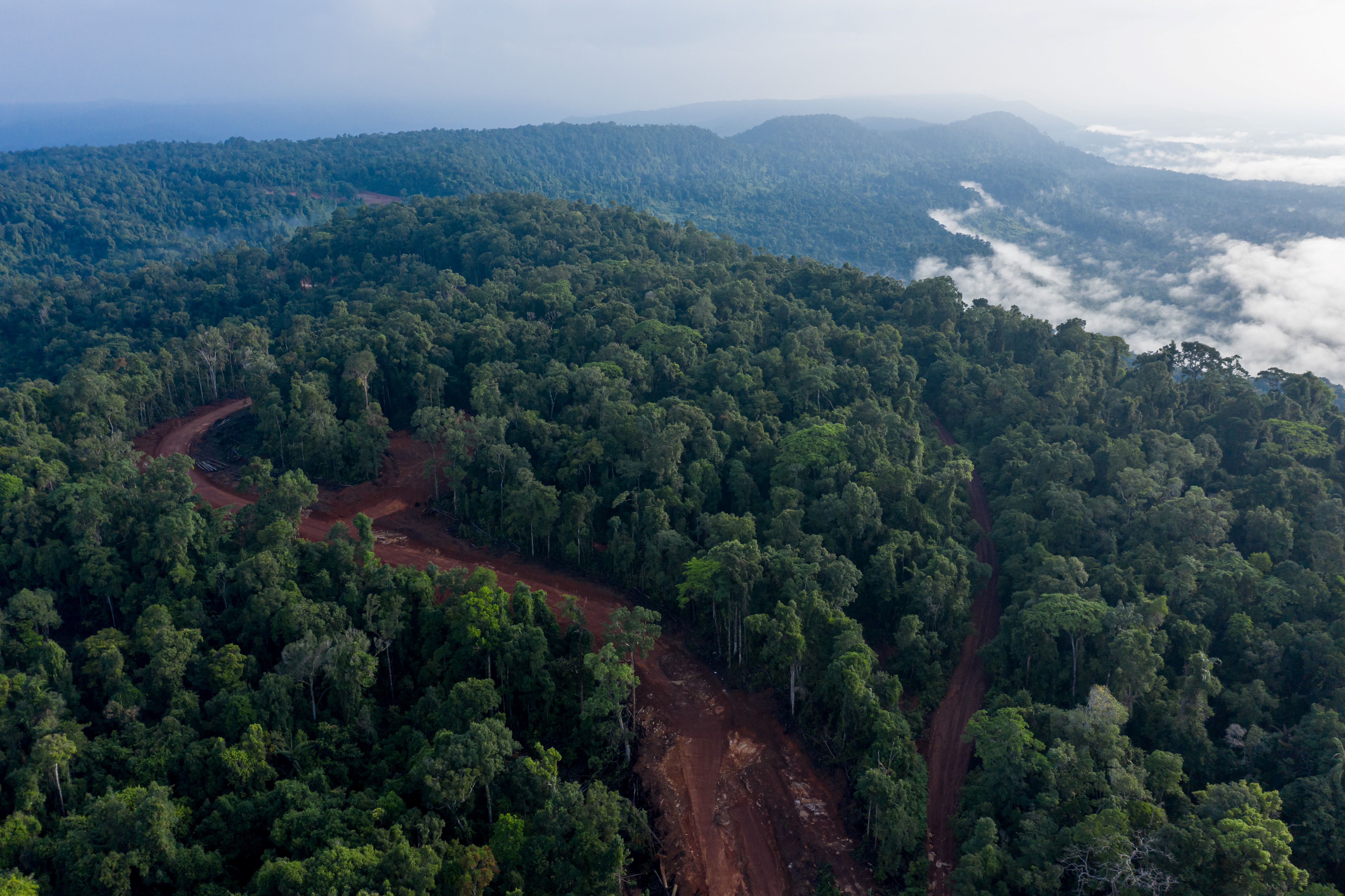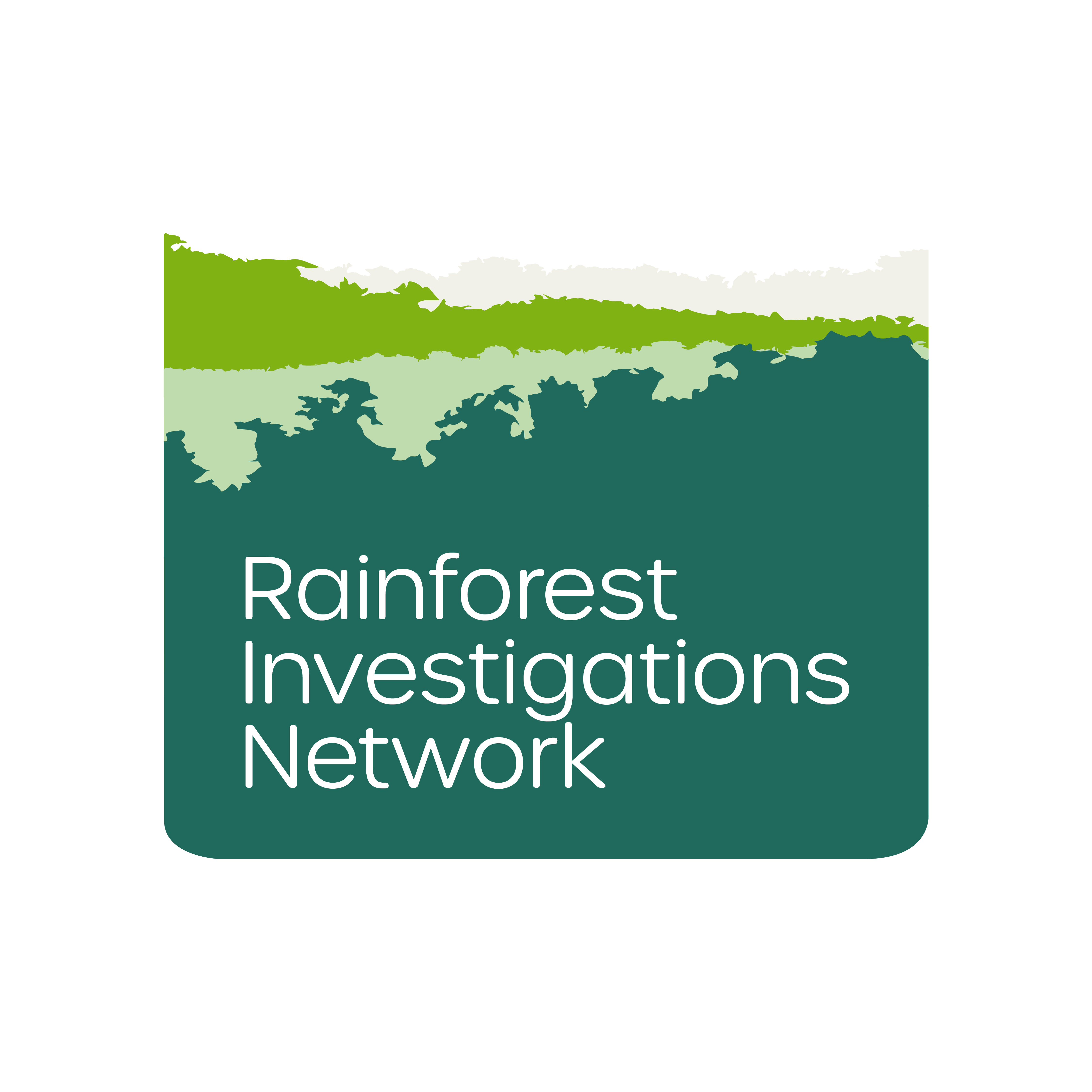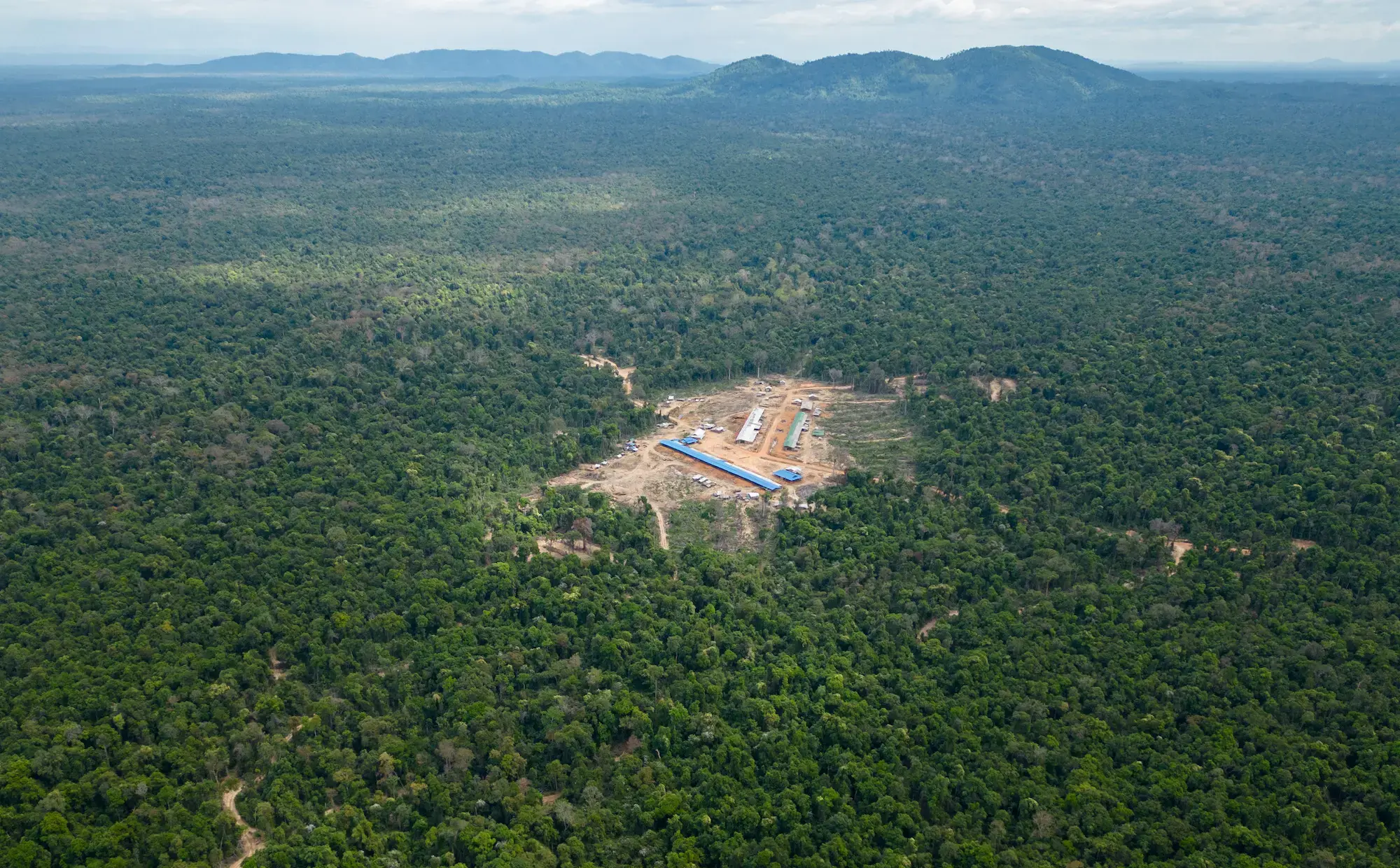
- A Mongabay investigation indicates that a three-star military general who also serves as a top interior ministry official appears to be the notorious illegal logger known as Oknha Chey.
- Family and business ties link Meuk Saphannareth to logging operations in northern Cambodia that satellite imagery shows are clearing forest well outside their concession boundaries.
- Officials at the provincial level could not give a clear answer as to why the concession had seemingly been awarded to Oknha Chey, while the interior ministry ignored Mongabay’s questions about the allegations against Saphannareth.
- Some names have been changed to protect sources who said they feared reprisals from the authorities.
SIEM PANG, Cambodia—“Us locals cannot source benefits from the forest anymore, only the Oknhas can find benefits in the forest now,” Samnang* said one afternoon in January, using a Khmer word for tycoons.
His farm sits on the eastern banks of the Sekong River, in Siem Pang, a district of Cambodia’s northeastern Stung Treng province, which shares a border with Laos. Behind his small patch of land, a vast canopy of green stretches out as far as the horizon, with densely forested mountains rising against the skyline.

Whistleblowers and others in possession of sensitive information of public concern can now securely and confidentially share tips, documents, and data with the Pulitzer Center’s Rainforest Investigations Network (RIN), its editors, and journalists.
Samnang pointed to faraway trails of smoke, the white wispy plumes the only indicator from the ground of human activity deep within the jungle. But Samnang and others living along the riverbank say they’ve been aware of the industrial logging operation for months.
Residents reported seeing a flurry of 18-wheel trucks repeatedly ferried across the Sekong River in the final months of 2022. The trucks returned full of timber, crossing back to the west side of the river where, villagers say, they were waved through newly constructed checkpoints set up alongside a road that was built sometime between March and April 2022, adjoining the new ferry crossing and an existing road that leads to Dong Kroloh village through a variety of older economic land concessions.

“The truck drivers used to stop here and eat; they’re not from this village,” said Sophy*, who runs a small restaurant on the side of the road linking the Sekong River to Dong Kroloh. “The police also come here to drink, they drink with the truck drivers, so do the Ministry of Environment rangers.”
Satellite imagery and data visualized on forest monitoring platform Global Forest Watch show road development began to expand from the Sekong River eastward into undisturbed forest in April 2022. By July, a network of roads and clearings had spread through some 6,000 hectares (14,800 acres) of primary rainforest. While most clearing took place mid-year, satellite imagery suggests road building and forest loss continued to occur in late 2022 and into 2023.
The forest that spans across Siem Pang and Sesan districts in Stung Treng was not protected at the time logging commenced, but it was still classified as state-public land, making it a crime to clear the forest without government permission. The forest also sits within a biodiversity corridor managed by the Ministry of Environment and is part of a 2017 initiative to connect Cambodia’s various protected areas via corridors spanning 1.43 million hectares (3.53 million acres) nationwide. However, the corridors themselves are not officially protected by the government.
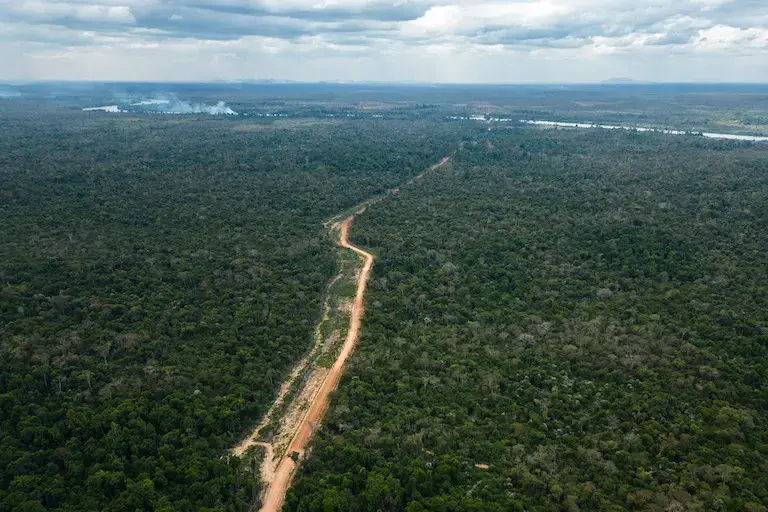
Compounding the matter further, the Ministry of Environment announced on Feb. 15 that it would be establishing a 110,651-hectare (273,425-acre) protected area that will stretch across both Siem Pang and Sesan districts, covering Phnom Krala Pors and the Sekong River.
But understanding how this new designation will affect the logging operation is difficult, as no public data have been released regarding the new protected area’s boundaries.
When shown images of the forest clearance currently underway and questioned about the viability of the protected area in the face of this forest loss, Ministry of Environment spokesperson Neth Pheaktra declined to comment specifically on the situation, but said in a general statement, “the Ministry of Environment has strong commitments to protect natural resource and is studying other potential areas to create the protected areas.”
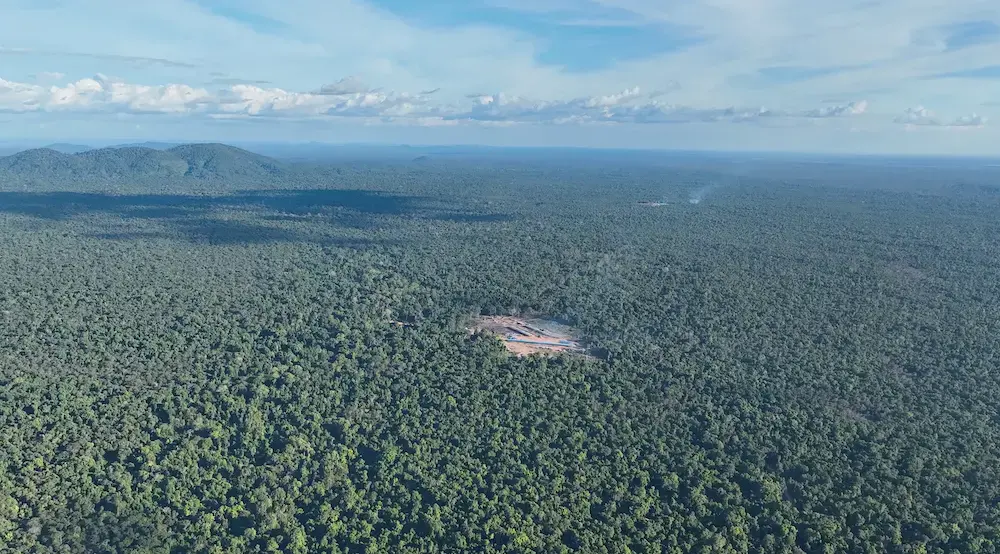
Sophy said Ministry of Environment rangers told her they were going to visit the logging operation while stopped en route at her shop. But their visit hadn’t stemmed the convoys of trucks that rush by her shop in the night. The drivers, she said, come from Pursat, Koh Kong, Prey Veng and Kampong Cham — historically forested provinces of Cambodia where logging is a profitable skill set.
“They drive the trucks up here, toward the river, from Kratie province,” she said. “Then, they come back out — from across the river — usually around midnight, two or three times per week. I recognized the sound of timber trucks. They vibrate the ground.”
Sipping a beer late one January evening, a local police officer sat by the side of the road, watching as dust kicked up by the sparse traffic caught the light from nearby shops. North of here, the road leads up to the Laos border; to the south, it takes drivers back to Stung Treng’s eponymous provincial capital.
“The road to Stung Treng has been damaged because of the timber trucks,” said the police officer, pointing to deep rivets etched into the dirt road. “This road is going to be expanded, because the timber trucks have damaged it so much, but [expansion] will affect everyone along the road. Many will lose land.”
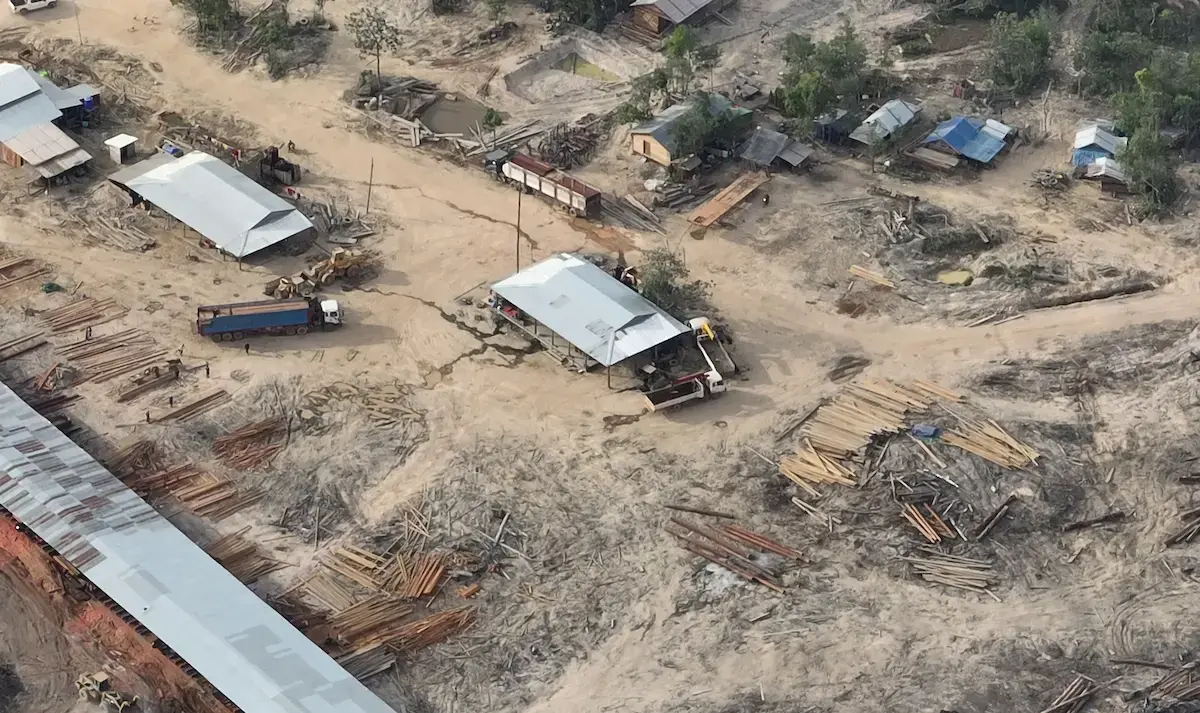
The police officer insisted the timber transportation was legal, which was why nobody checked the contents of the vehicles. When asked why, if it was legal, the trucks only transported timber at night, the police officer looked away for a moment.
“They transport timber at night because it helps to keep the wheels cool,” he said, before returning to his beer.
‘Only Oknhas can take the timber’
According to residents of Dong Kroloh, the company behind this new timber operation belongs to one Oknha Chey, a pseudonym well-known locally that roughly translates to “victorious tycoon.”
“I don’t dare speak much about the timber trucks, because if I give you information, the company will kill me,” said Rozy*, who also owns a shop farther down the road from Sophy. “The authorities want to move us off this road so the timber trucks can go past, but the truck drivers sometimes stop here to buy snacks; they don’t tell me where they take the timber to or where they sell it.”
Rozy said that business along the dusty stretch of red-dirt road has picked up in recent months — not just in the form of loggers, but also due to the volume of workers “coming for a job with Oknha Chey.”
None of Dong Kroloh’s residents would speak on the record about the new land concession or the logging operation or Oknha Chey, but most said they had heard the mysterious tycoon’s name in recent months from timber truck drivers passing through and from loggers who returned from across the river twice a month to buy food and supplies.
Many in Dong Kroloh remain acutely aware of the high-profile murders and violence that have often accompanied the illicit timber trade in Cambodia, particularly when directed at journalists reporting on it.
Despite this, Oknha Chey’s alleged role in facilitating the felling and sale of Stung Treng’s forests remains an open secret among the small community of Dong Kroloh.
“It’s Oknha Chey’s checkpoints along the [road to the Sekong River],” said Sok Chan*, another villager. “Everyone in the village knows [of] Oknha Chey, we all know that it’s his land where they’ve built the checkpoints and so I think it is him clearing the forest on the other side of the river. Oknha Chey is very well known in this area, especially over the last year, he’s got connections to Vietnam, so I think he will sell the timber over there; only Oknhas can take the timber.”
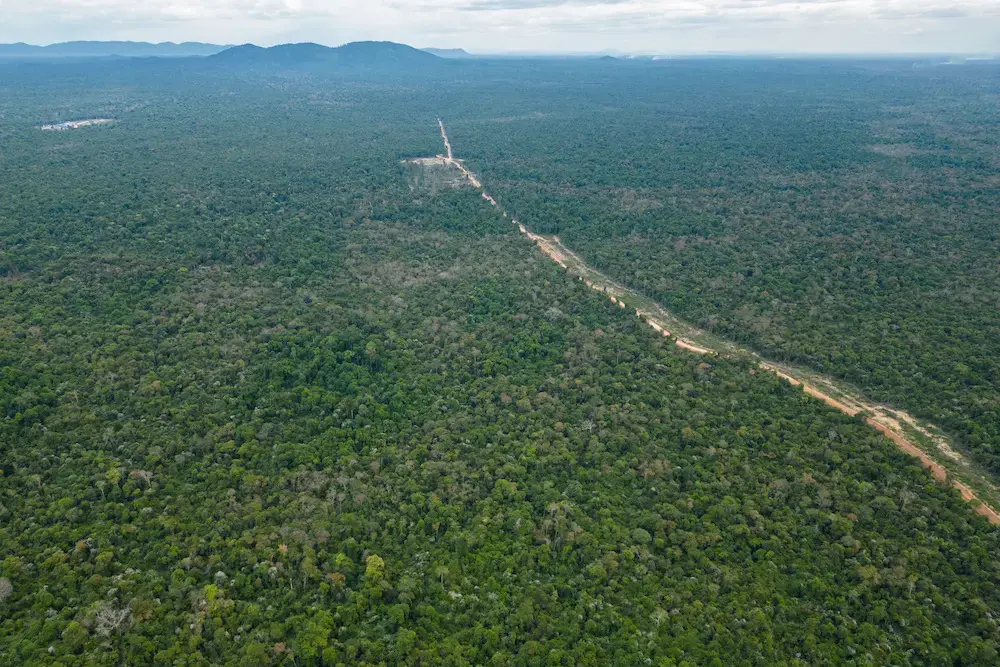
Sok Chan was not alone in saying the timber allegedly taken by Oknha Chey was bound for Vietnam. Many villagers agreed that the price of the wood, mostly hardwood species, would more than double if sold to Vietnamese buyers across the border.
“Here the reddish kind of wood can sell for maybe $180 or $190 per cubic meter,” explained Davuth*, a former timber trader and logger. “But if they take it Stung Treng town and then to Vietnam, they can sell it for $470 to $500 per cubic meter.”
Each truck, multiple sources said, could hold between 50 and 60 cubic meters (1,770-2,120- cubic feet) of wood. When asked how they knew this, most sources said they knew people who had worked for Oknha Chey’s logging operation in recent months.
Tracking the timber traders
While Stung Treng residents living near the forest were all familiar with the nickname Oknha Chey, none could provide his real name or that of his company. Most simply said they believed it was a South Korean company operating the sawmills and taking the timber, but that this company was under Oknha Chey’s control.
The South Korean connection stems from a March 11, 2022, letter from Cambodia’s cabinet, formally known as the Council of Ministers, seen by Mongabay, which announced that a 9,788-hectare (24,187-acre) economic land concession had been issued to Horizon Agriculture Development. The move prompted rights groups to question whether the government had violated its own 2012 moratorium on issuing new economic land concessions.
“The government should provide more information on what appears to be a reversal of the moratorium on new [economic land concessions],” Naly Pilorge, outreach director of LICADHO, said in a press release.
Im Rachna, a spokesperson for the Ministry of Agriculture, Forestry and Fisheries, did not respond to detailed questions from Mongabay, but did deny that Horizon Agriculture Development’s land acquisition represented a new concession when speaking with local media.
Rachna also did not respond to multiple requests to verify what appeared to be government documents detailing the boundaries of a concession held by the company T.S.M.W. However, the Stung Treng provincial Forestry Administration chief, On Chansochheat, did not refute the concession map when interviewed by Mongabay reporters, and multiple forest activists said that the document appears genuine and pointed out that it has been repeatedly published by local media and local rights groups.
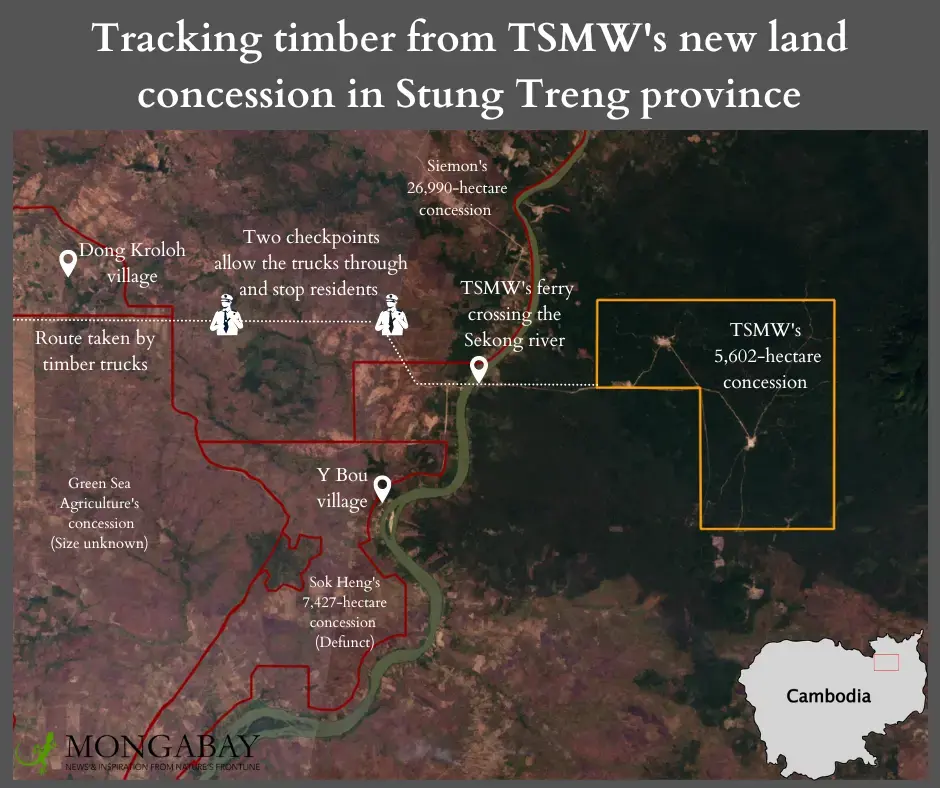
Instead, the government argued that Horizon Agriculture Development, a South Korean agribusiness company, received the land in Stung Treng province as compensation after its original 3,734-hectare (9,227-acre) concession in Kratie province was revoked following a 2014 land dispute. At least 1,562 hectares (3,860 acres) of Horizon’s original concession was awarded to communities who said Horizon had taken their land in Kratie’s Snoul district, but it’s unclear whether the company retained the rest of its concession.
Records indicate that Horizon last re-registered with the Ministry of Commerce in May 2016, while its last known annual tax returns were filed in May 2018. Calls to the one phone number listed for both Horizon’s directors, Lim Joo Heon and Wang Pan Sheng, were answered by a Khmer-speaking person who said he didn’t work for Horizon before hanging up.
One source with intimate knowledge of Cambodia’s legal framework for businesses, and who requested anonymity for fear of retaliation, said that Horizon’s lack of declaration regarding business activity — which is legally required to be submitted annually for companies to be accredited by the Ministry of Commerce — suggested that Horizon was no longer operational in Cambodia.
Despite this, the Council of Ministers’ letter from March 2022 granted Horizon the right to transfer its newly acquired land concession to T.S.M.W., a Cambodian company, while also instructing the Ministry of Agriculture, Forestry and Fisheries to begin establishing legal documents to grant a 50-year lease on the land.
In July and September 2022, separate letters from the Forestry Administration and the Ministry of Environment respectively confirmed that a 5,602-hectare (13,843-acre) concession had been issued to T.S.M.W.
T.S.M.W. in conflict with communities
Collectively, the government documents suggest that the original 9,788 hectares would be issued across Borei O’Svay, Siem Pang and Sesan districts in Stung Treng province. But only 5,602 hectares had been identified in a plot that straddles the border of Siem Pang and Sesan districts, leaving 4,186 hectares (10,343 acres) of compensated land, ostensibly in control of either Horizon or T.S.M.W., unaccounted for.
“The 9,000 or so hectares are spread across three districts: Siem Pang, Sesan and Borei O’Svay,” Ly Mina, district governor of Borei O’Svay, told Mongabay in an interview. “Another company, Sok Heng, was granted an [economic land concession] a long time ago, it was handled by the Ministry of Agriculture, but Sok Heng failed to develop their concession and after studying it, the government decided to lease it to T.S.M.W. It was about 4,000 hectares [9,900 acres].”
Satellite imagery shows the Sok Heng concession was once forested land, but has long sat barren amid a number of other concessions that also displayed limited signs of development.
With T.S.M.W. apparently inheriting the remaining 4,186 hectares of the 9,788-hectare compensation package currently being carved out of the defunct Sok Heng concession, residents in the nearby village of Y Bou told Mongabay reporters that they fear their land tenure is on the line.
The land dispute is what initially raised the profile of T.S.M.W.’s concession on Jan. 16, with local rights group LICADHO calling on the government to publish the social and environmental impact assessments legally required to have been conducted ahead of the issuance of a new land concession.
Situated on the west side of the Sekong River, Y Bou sits within Borei O’Svay district. Residents there said that they had recently been unexpectedly joined by heavy equipment and the operators clearing land toward their village.
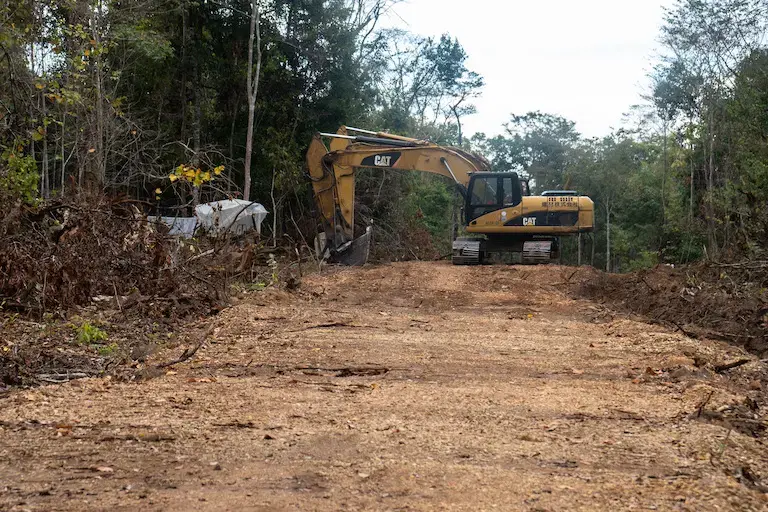
Following a newly dug ditch and deforested path, Mongabay reporters located one bulldozer and one excavator. Their operators said they had been on the job just one month and were “clearing a belt around the forest” for $400 a month, although they claimed not to know who was paying them.
“If they want to come here and do business, they need to leave some land for us, the locals, because we depend on the land for our own businesses,” said Y Bou resident Heng*. “They cannot just take all of the land for their own business.”
Heng also mentioned that around the same time as the bulldozers had come to his village, he’d seen trucks crossing the Sekong River by ferry — back and forth, empty and then laden with timber.
“We know that all across the forest over the river, people are cutting down the trees,” he said, without naming T.S.M.W. or Oknha Chey. “We don’t know if it’s the same company, but who else could it be? Who else can bring bulldozers and excavators into the forest like that?”
Who is Oknha Chey?
While Mongabay could not ascertain the true identity of Oknha Chey, the moniker has been in use since at least 2017 and clues point toward the Ministry of the Interior.
Ouch Leng, a Goldman Environmental Prize-winning forest activist who has repeatedly visited the T.S.M.W. concession, said he has come across the name Oknha Chey multiple times in recent years while investigating illegal logging across Cambodia.
“Oknha Chey has been reportedly embroiled with the illegal logging business for years, with non-stop timber exports supplying to international markets, specifically to Vietnam and China, for reexport to European or U.S. furniture markets,” Leng said.
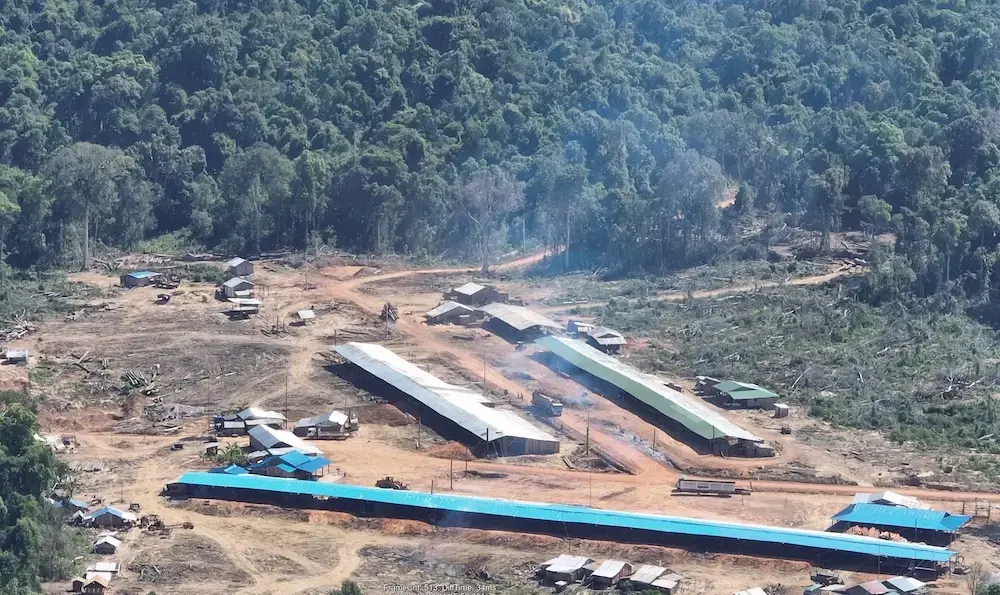
Leng alleged that Oknha Chey also played a role in illegal logging operations that plagued the development of the Lower Sesan 2 hydropower dam in Stung Treng province. The project broke ground in 2013, spearheaded by Cambodia’s largest conglomerate, Royal Group, but allegations of illegal logging arose repeatedly from 2017 until the dam was completed in December 2018.
In February, a police officer who said he had been stationed at the dam’s checkpoint for almost eight years told Mongabay that Oknha Chey was working with Royal Group CEO Kith Meng to clear forest in what would become the reservoir while the dam was being built. He also said there had been irregularities regarding timber exports, which were banned by Prime Minister Hun Sen in 2016, but said he didn’t know Oknha Chey’s real name.
A November 2017 report from local media also alleged Oknha Chey had been transporting timber from Sesan district, just south of T.S.M.W.’s concession, during the construction of the hydropower dam, this time identifying the leader of the operation as Meuk Saphannareth. The article also alleged that Oknha Chey had previously transported timber from Anlong Veng and Trapeang Prasat districts in Oddar Meanchey province through a company called Hout Meng Rita.
Throughout 2017, Oknha Chey was repeatedly linked to Hout Meng Rita’s logging operation in Oddar Meanchey, with multiple local journalists alleging the company was exporting valuable timber to Vietnam through Stung Treng and Kratie provinces.
Separate allegations came in 2020 when Oknha Chey was again identified as Saphannareth in a news report detailing his alleged collaboration with Chea Pov, chairman of Angkor Plywood — a company steeped in controversy over its widely reported role in the logging of Prey Lang Wildlife Sanctuary.
Together, Saphannareth and Pov were accused by a variety of sources, including forest activists and local officials, of orchestrating a large-scale illegal logging operation in Stung Treng’s Siem Pang district — the same area where T.S.M.W. has been given a license to log. The alleged cooperation between Chea Pov and the alias Oknha Chey was raised again in late 2022 by local media, this time accusing the pair of laundering timber through a separate concession in Siem Pang district.
Several other local outlets and reporters identified Oknha Chey not only as an alias for Meuk Saphannareth, but also suggested that Saphannareth is a three-star military general.
Cambodia’s publicly available electoral register shows only one Meuk Saphannareth registered to vote (even when attempting various Khmer language spellings of the name); that Meuk Saphannareth happens to be a three-star general — as well as deputy director of the General Department of Prisons at the Ministry of the Interior.
Mongabay reporters discovered a Facebook account using the name Hout Meng Rita that has repeatedly posted photos and videos of Saphannareth and his family, while also showcasing Saphannareth’s connections to Prime Minister Hun Sen and the prime minister’s son, Army chief Hun Manet, who is widely expected to become Cambodia’s next leader when his father steps down. The account’s domain is “naret.chey.5” — which includes portions of both names Meuk Saphannareth and Oknha Chey.
A question of spelling
Nouth Savna, a spokesperson for Cambodia’s General Department of Prisons, declined to share Saphannareth’s contact details. On Feb. 22, Mongabay reporters delivered a letter to the Ministry of the Interior questioning Saphannareth’s role in the timber trade, whether he used the moniker Oknha Chey, and whether he had any response to the allegations of illegal logging associated with that name.
The same day, two men claiming to be legal assistants to Meuk Saphannareth sent a document to reporters in which Saphannareth ignored most of the questions put to him.
Instead, the letter stated, “My name is Mek Saphanareth, and I would like to confirm that I am a civil servant (in the state code) in accordance with the General Statute of Civil Servants, unable have my name as the company director or Okhna.”
The Khmer language spelling of his name provided by Saphannareth yielded no results when searched across all 25 provinces in Cambodia’s publicly available voter list, but the spelling used publicly and by the prisons department itself finds one Meuk Saphannareth registered to vote in Phnom Penh at polling station 2080, where Saphannareth can be seen voting through his wife’s posts on social media.
The letter did not deny Saphannareth’s involvement in the timber trade in Cambodia or Vietnam, but his legal assistants attached another letter, ostensibly from then-Stung Treng provincial governor Mom Saroeun addressed to Interior Minister Sar Kheng, in response to a local news report from 2019. The attached letter is dated July 1, 2019, and was originally written in Khmer before being translated to English by a Mongabay reporting team, with the translation verified by multiple reporters fluent in Khmer and English.
The letter references a March 27, 2019, article published by Moneaksekar Khmer that alleged Oknha Chey is a military general named Meuk Saphannareth and was involved in illegal logging during the construction of the Lower Sesan 2 dam. But Saroeun’s July 2019 letter to Kheng notes that only Ang and Associates, a law firm owned by Royal Group’s Kith Meng, had been given permission to transport timber out of the dam and that “there is no signature requested by Meuk Saphannareth, there is only the official name of the company representative.”
In the 2019 letter, Saroeun wrote “In the case of Meuk Saphannareth, alias Oknha Chey, which was published by Moneaksekar Khmer news outlets on March 27, 2019, the professional institution has never issued a permit to transport non-timber forest products and has never been asked for the transportation of non-timber forest products from the above name from the target of Sesan district, Stung Treng province.”
Saroeun’s letter suggests that any logging or timber transport that Oknha Chey engaged in at the Lower Sesan 2 was not sanctioned by the government. When reached by phone, Saroeun said he would read the letter, but has not responded since to confirm its veracity.
A family business?
Ministry of Commerce business registration records compiled and displayed by the platform Open Development Cambodia list Saphannareth’s wife, An Soknin, as one of the four directors of Hout Meng Rita — one of the companies reportedly controlled by Oknha Chey. The company’s name, Hout Meng Rita, is itself an amalgamation of the names of Soknin and Saphannareth’s three children, Naret Lyhout, Naret Lymeng and Naret Narita. It is also the profile name of the Facebook account that appears linked to Saphannareth.
The company Hout Meng Rita was awarded two concessions totaling 4,195 hectares (10,366 acres) of forested land in Oddar Meanchey province between 2011 and 2012. Similar to T.S.M.W.’s concession, satellite imagery from Global Forest Watch shows the parcels of land awarded to Hout Meng Rita were largely covered with primary forest that the company soon began clearing.
Industrial-sized sawmills and timber depots can be seen via satellite imagery from 2013 along the northernmost concession’s borders, with roads directly linking them to Hout Meng Rita’s concessions.
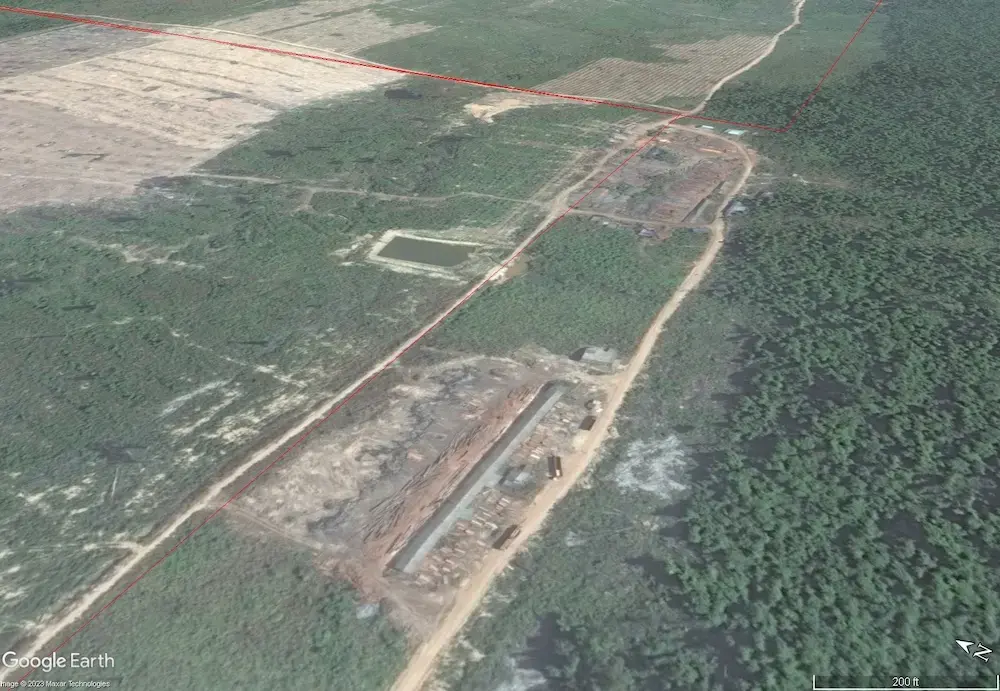
This operation was not Soknin’s alone. Leng Rithy, another of the four directors at Hout Meng Rita, also served as the Cambodia representative to Vietnam Rubber Group (VRG) and as president of the Vietnamese Rubber Enterprise Federation. In 2013, Rithy was accused by the NGO Global Witness of masterminding a series of forest and land grabs across Cambodia under the guise of rubber plantation development.
“The negative impact of VRG and HAGL’s activities is hard to overstate,” the report read, going on to accuse VRG and Hoang Anh Gia Lai (HAGL), another Vietnamese rubber conglomerate with strong ties to Cambodian elites, of various violent human rights abuses, including dispossessing Cambodia’s Indigenous communities of their “spirit forests.”
“Member companies of VRG appear to have high-level connections with Cambodian government officials and have partnered with a notorious illegal logging syndicate,” Global Witness wrote shortly after Hout Meng Rita was awarded forested land parcels in Oddar Meanchey.
While Soknin’s company Hout Meng Rita was never linked to the illegal logging reportedly connected to the construction of Royal Group’s Lower Sesan 2, her family appears to share a close connection with that of Royal Group’s chairman, Kith Meng.
Soknin’s social media posts show herself and Saphannareth attending dinner parties and birthday parties with Kith Meng in 2018 and 2019, around the same time that allegations began swirling regarding Oknha Chey’s involvement in the clearance of the Lower Sesan 2’s reservoir.
Both Soknin and Saphannareth also hold ranks within the Cambodian People’s Party (CPP) Youth Organization, a subgroup of the CPP’s diplomatic wing headed by Prime Minister Hun Sen’s eldest son, Hun Manet, that mobilizes support among the party faithful at home and abroad.
Saphannareth and Soknin feature prominently in the CPP West Coast Team, a small part of the CPP Youth Working Group in the U.S., with Saphannareth heading up the CPP’s Utah chapter and his wife serving as the chapter’s deputy.
Curiously, the CPP Utah Youth Working Group’s Facebook page was, until Saphannareth was contacted by Mongabay, listed as a furniture shop that appears to have been selling ornaments crafted from wood since at least 2014.
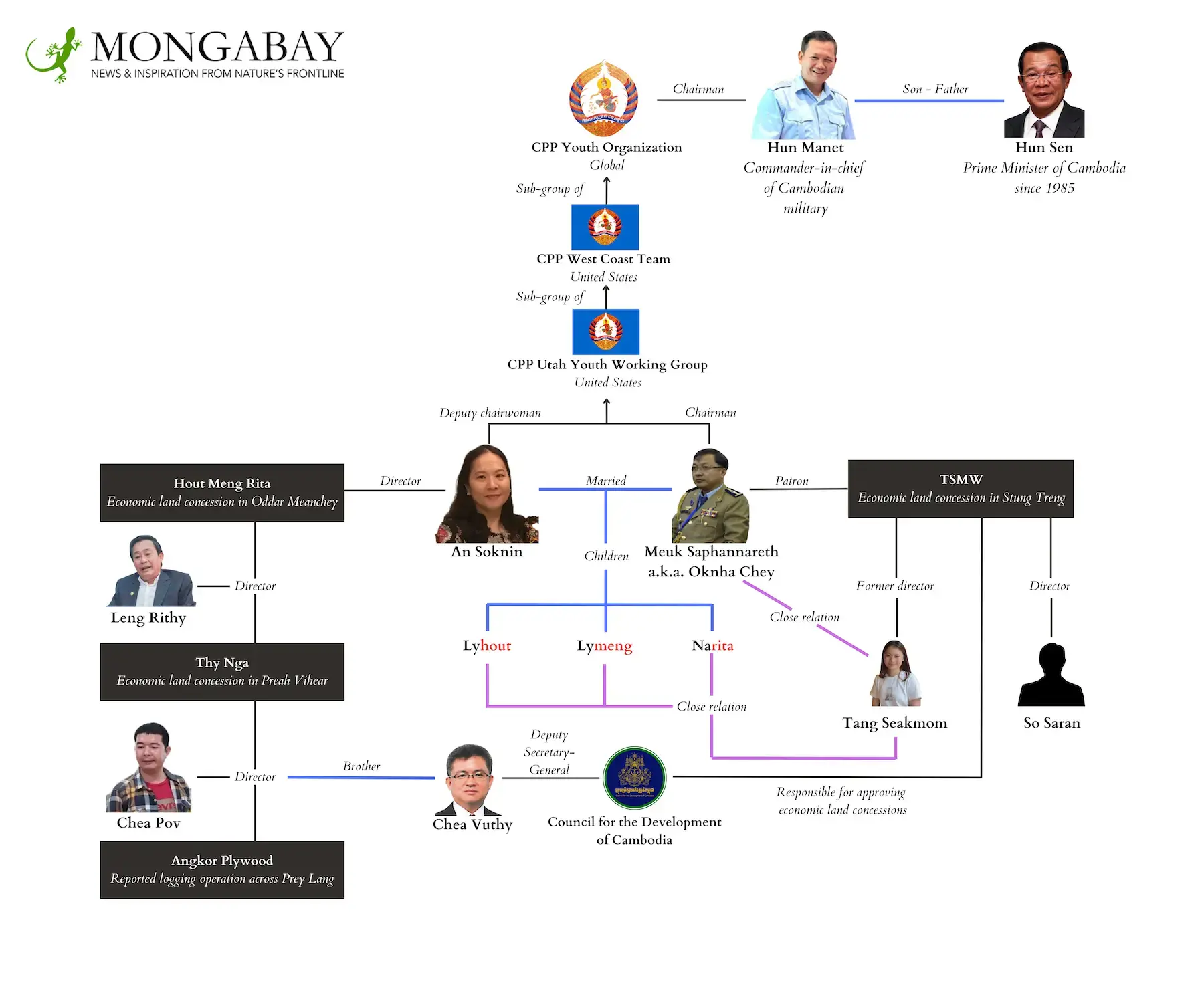
Further connecting Soknin to the timber trade is an address tied to Soknin through her business ventures, which sits within a gated community, known locally as a borey.
Security guards confirmed the address belongs to the owner of KTV Banteay Srey, a now-defunct brand of karaoke bars that Ministry of Commerce records show Soknin directed.
Outside, a car with personalized license plates reading “NARITA99” — presumably belonging to Saphannareth and Soknin’s daughter — was spotted by reporters.
Within the borey, Soknin’s house stands out from its neighbors. While the other houses are stylistically similar white concrete buildings, Soknin’s appears to be constructed mostly of wood.
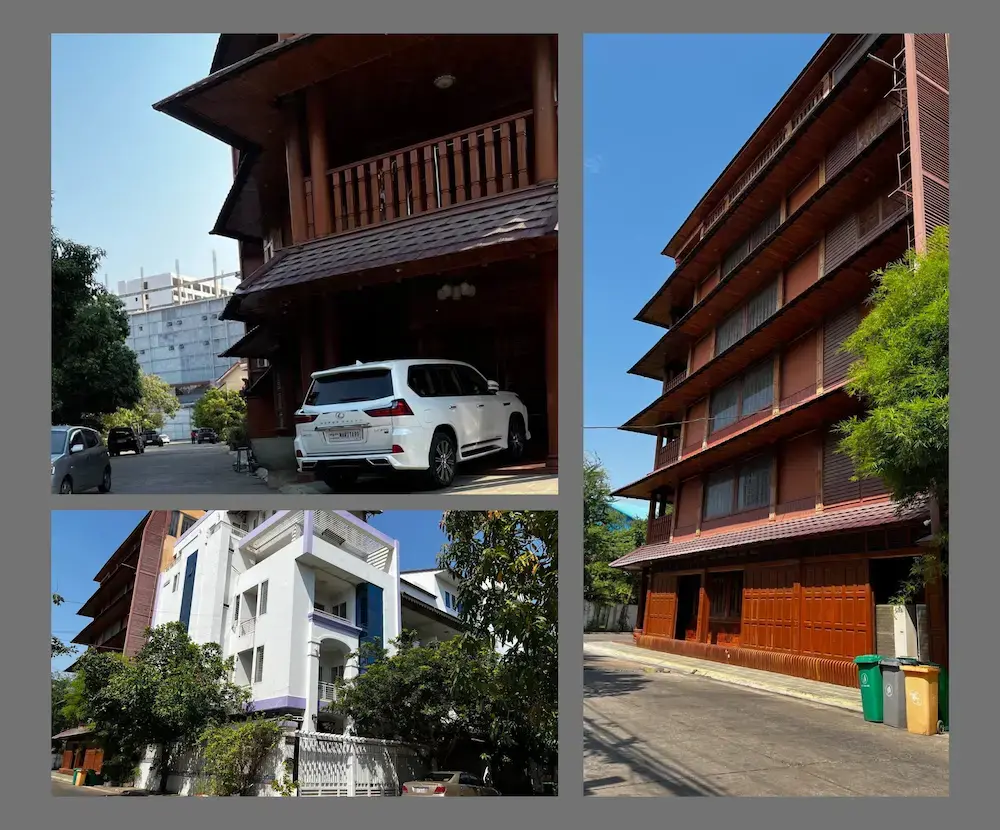
This appears to be a trend set by Cambodia’s timber traffickers, with luxury wood magnate Try Pheap’s resorts in Sihanoukville and Kep both mirroring the style of Soknin’s house. Pheap, who was hit with U.S. Magnitsky sanctions in December 2019, has well-documented connections to the timber trade and appears to adorn much of his property and real estate with the luxury timber his empire was founded upon.
Soknin did not respond to emailed questions regarding allegations that her husband was Oknha Chey, the alleged involvement of Oknha Chey in Hout Meng Rita, or the company’s logging operations in Oddar Meanchey.
Oknha Chey, Muek Saphannareth and T.S.M.W.'s concession in Stung Treng
Further connections between the alias and Meuk Saphannareth were uncovered while investigating villagers’ claims that T.S.M.W.’s logging operation in Stung Treng is controlled by Oknha Chey.
Incorporated in May 2019, T.S.M.W. initially listed Tang Seakmom as the sole director of the company, before she was removed and replaced by So Saran in October 2019. However, contact details for Saran could not be found and corporate records list only Seakmom’s contact information.
Photos used on Seakmom’s Telegram account matched those on her Facebook account, where photos indicate she has a personal relationship with the family of Saphannareth, Soknin and their three children.
Across social media platforms, Seakmom can be seen going to vote in the 2018 national election with Saphannareth and Soknin (typically a family activity in Cambodia), attending family ceremonies at a pagoda, embarking on family holidays to Koh Rong, celebrating the birthdays of Saphannareth and Soknin’s children, as well as picking up their eldest daughter from the airport upon her return to Cambodia. Seakmom can be seen joining Saphannareth on a family trip as recently as January.
Seakmom’s exact relationship with Saphannareth’s family could not be discerned, and when asked about it over the messaging app Telegram, Seakmom said that “As you already know, I [stopped] working there and I don’t have any connection with that company anymore.”
Seakmom declined to answer questions about the relationship between her and Saphannareth, but did not deny such a relationship existed, before blocking reporters on Telegram. She did not respond to repeated phone calls following the initial messages on Telegram.
Neither Saphannareth nor Soknin denied having a relationship with Seakmom when reached for comment, but neither detailed its exact nature.
Another link between T.S.M.W. and Oknha Chey came in 2020 when Ank News reported that trucks believed to be owned by Oknha Chey were accused of transporting timber to a different depot than the one cited in the transport permits issued by the Forestry Administration. Among the Khmer-language documents published by Ank News, the signature of T.S.M.W.’s current director, So Saran, can be seen in a list of participants at a meeting with government officials.
When asked why Oknha Chey, a name connected to illicit timber, was granted a concession of densely forest land in his jurisdiction, Phan Yuth, district governor of Siem Pang, said, “You can ask him. His group has not contacted me. I don’t know their plan.
“You’d better ask the [national] government. How can I know about it? I am not the person who granted it to him,” Yuth said in a phone interview in January.
“I don’t have an answer to this question,” said Men Kong, a spokesman for the Stung Treng provincial government, when asked in January why Oknha Chey’s company, T.S.M.W., was given thousands of hectares of forest across three districts, despite a litany of allegations regarding illegal logging.
“In principle, the provincial authority doesn’t have the right to decide to grant land [concessions] to any Oknha or company,” he said. “We just follow the government’s policy.”
Tum Yaro, director of Stung Treng province’s Department of Agriculture, claimed to have no knowledge of what crop T.S.M.W. would plant on its concession or what would be done with the timber. He said he was aware of a logging operation in the forest, but not of the name Oknha Chey.
Stung Treng provincial Forestry Administration chief On Chansochheat initially did not address or deny Oknha Chey’s involvement in T.S.M.W. when interviewed by phone in January.
“Regardless of the individual, for those who violate regulations, we will take legal action,” he said. He would not elaborate on what that legal action might look like. “Regardless of any specific individual, whoever [breaks] the regulations, whether it is to transport or whatsoever, that is against the law, we don’t allow this to happen.”
Chansochheat said that T.S.M.W. has the right to clear the forest and sell the timber, but only domestically; an international sale would require an international permit. Chansochheat grew angry when informed that Stung Treng residents suspected that Oknha Chey could be selling timber to Vietnam, given the tycoon’s reputation.
“No. That is not true. Who said this?” he said. “No. What people say is not true. Where T.S.M.W. are licensed to take wood to, they will [take it] there. [The wood] isn’t going out [of the country].”
Chansochheat also noted that if the company were to clear forest outside its concession, this would be a forest crime and he would gather evidence to begin legal procedures against T.S.M.W.
Satellite data and imagery from Global Forest Watch show that clearing is indeed happening well beyond the boundaries of the concession as indicated by what sources say is official allotment documentation. Access to T.S.M.W.’s concession is heavily restricted by multiple checkpoints and guards, rendering the possibility of logging by locals slim. Similarly, the logging routes lead directly from inside the concession, over its borders and spilling out into the base of the nearby uninhabited mountain.

After being presented with this evidence over Telegram, Chansochheat said, “We will take legal action, no matter who they are, if they violate the regulation,” and then promptly hung up on reporters.
None of the provincial officials initially denied Oknha Chey was at the helm of T.S.M.W., none questioned his alleged history of illegal logging, and none could give a clear answer as to why the concession had seemingly been awarded to Oknha Chey or what the company would do with the land once the forest was cleared.
In subsequent phone interviews in February, both Chansochheat and Kong later denied that Oknha Chey controlled T.S.M.W. but declined to explain why they had not denied this allegation in initial interviews.
Chasing timber trucks
Leng, the forest activist, said he was repeatedly able to follow trucks as they left T.S.M.W.’s concession at night in January and February. Each of the trucks Leng was able to tail traveled some 500 kilometers (300 miles) south, toward the capital, Phnom Penh. Laden with timber, each journey took more than 14 hours.
The most recent delivery of wood was made to Angkor Plywood’s factory, which sits close to the border of Phnom Penh, in Kandal province. Leng was able to follow the truck through the night until it reached Angkor Plywood’s facilities around noon the following day in February.
“In the beginning, we had never done business with T.S.M.W.,” said a representative of Angkor Plywood in an interview with Mongabay. The representative, who has worked in Cambodia’s timber business since the early 1990s, requested their name not be published for fear of retaliation from the government. “But about 14 or 15 days ago, we purchased timber from a depot that said they had sourced wood from T.S.M.W.”
When asked about Oknha Chey’s alleged control of T.S.M.W., the Angkor Plywood representative said, “As I know, it is true. Generally, in the forestry sector, nobody can keep hiding like this. I’ve met him around 10 times in the last 10 years, I believe he works for the government, within the Ministry of the Interior.”
Angkor Plywood’s representative explained how they had witnessed police officers refer to Oknha Chey as “Brother Reth” and that they had heard from their network within the timber trade that Oknha Chey was the ultimate beneficiary of Hout Meng Rita, as well as one of the last loggers operating in the Lower Sesan 2 before its completion.
Reporters then showed the company representative a photo of Meuk Saphannareth, whom the representative identified as Oknha Chey: “I’m sure [that is him].”
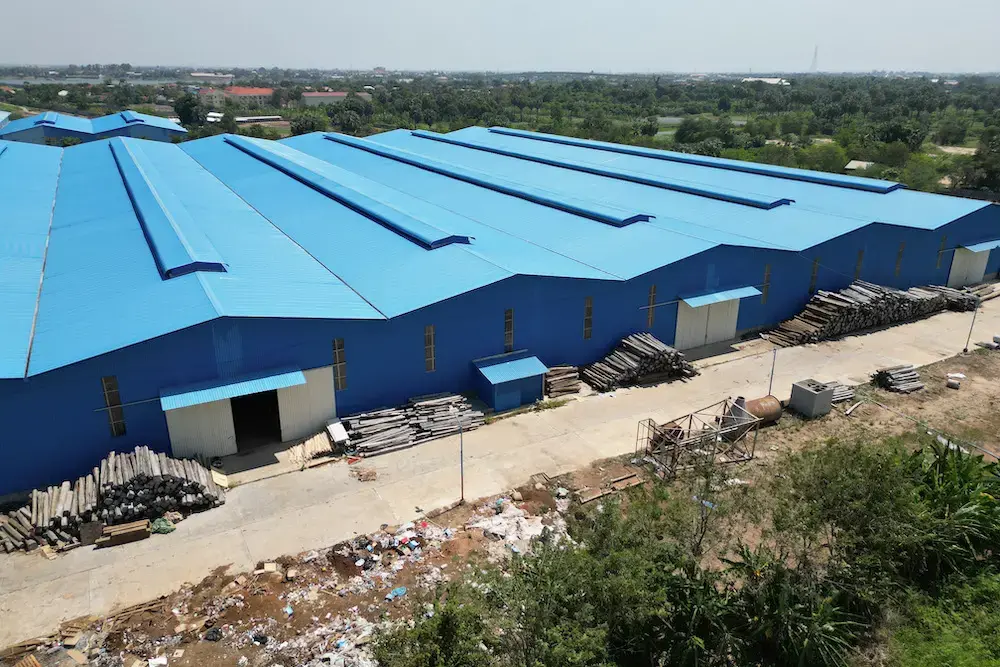
Many of the trucks Leng was able to follow from T.S.M.W.’s concession passed close along the Vietnamese border, a route that the Angkor Plywood representative said would likely result in some wood being offloaded or sold.
“If there is a permit [to transport wood] in that area, then there is likely wood smuggling. Any timber brought close to the border will not be for local use,” the representative said.
Leng said that other depots where he observed T.S.M.W. timber being transported to appeared to be new, purpose-built for a fresh influx of wood. One in Ta Aek commune, Kandal province, some 100 km (60 mi) from the Vietnamese border, is, according to Angkor Plywood’s representative, owned by a Cambodian military general.
“They’re outsiders [in the industry], I heard it’s a one-star or maybe two-star general running that depot, the name of the guy is Sokha, I’ve met him before, but I don’t know him,” the representative said.
Other trucks came to rest near the Prek Pnov bridge in Phnom Penh, close to the safari park owned by Cambodian senator and tycoon Ly Yong Phat, but Leng determined that the wood was not delivered there. Rather, the area was used as a truck stop by drivers, before continuing on to depots around the Cambodian capital, including Angkor Plywood’s factory in Kandal province.
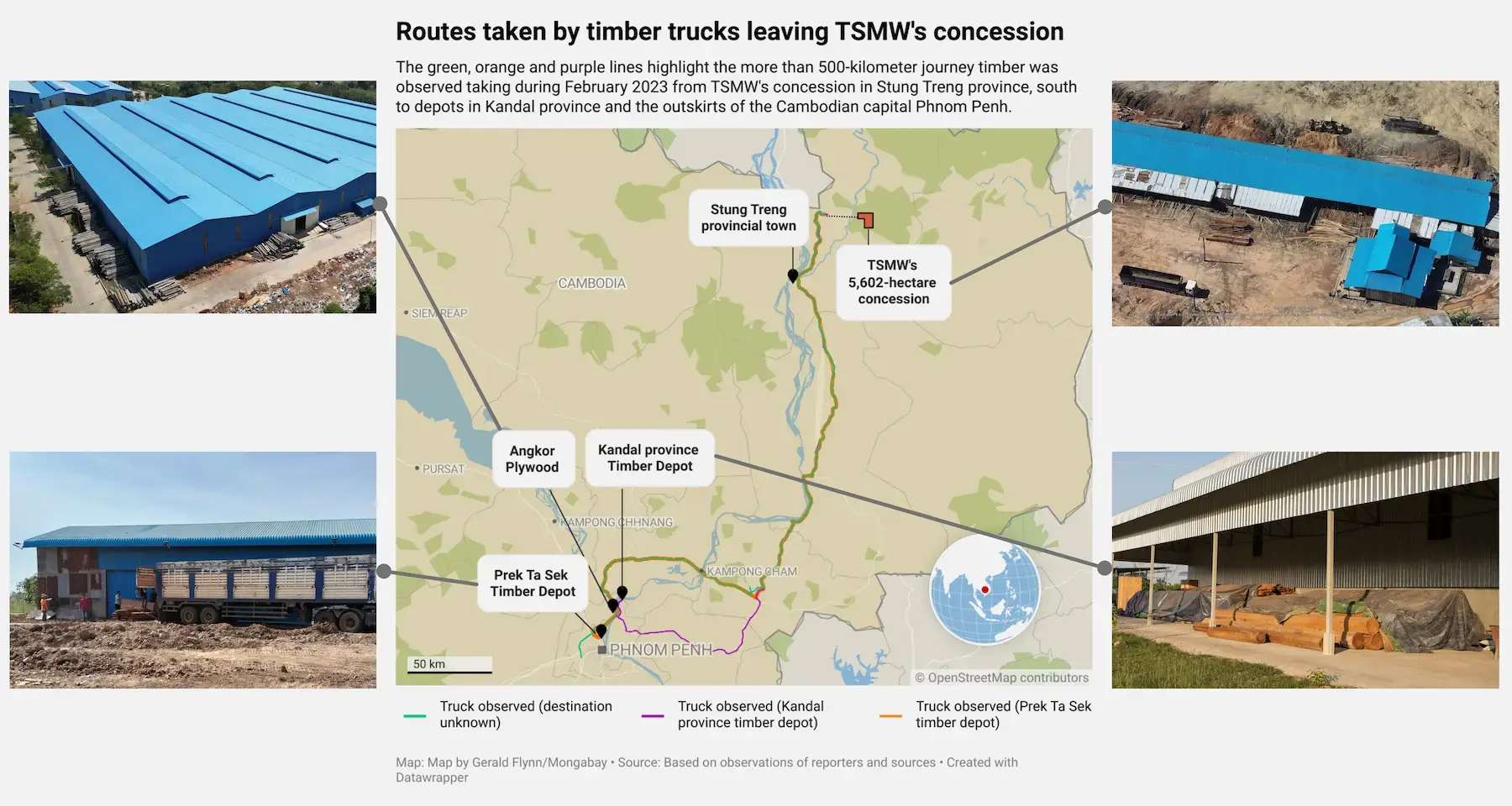
“Previously, people have said that Angkor Plywood is smuggling wood, but I’ve never done such a thing, everything I do, I do legally,” the representative said. “For some kinds of wood, it is necessary to buy from depots [supplied by T.S.M.W.], but we only buy because we believe that’s not illegal.”
Another land concession gained, another forest lost
Regardless of its ownership, T.S.M.W.’s concession in an old-growth forest, which has since been designated as a protected area by the Ministry of Environment, stands in stark contrast to the “strong commitments to protect natural resource[s]” that ministry spokesperson Neth Pheaktra espoused.
The use of concessions to effectively privatize Cambodia’s forests, and the consistent evidence across concessions of logging taking place beyond their boundaries, has sent Cambodia’s deforestation rates soaring, with roughly 2.6 million hectares (6.4 million acres) of forest cover lost between 2001 and 2021, according to Global Forest Watch.
“It’s a classic timber grab,” said veteran forest expert Marcus Hardtke, who has studied and advocated for Cambodia’s forests since the 1990s.
Hardtke said the government and timber traders have long abused Cambodia’s economic land concessions to cover illegal logging operations and to launder illegally cut wood, but noted that in the case of T.S.M.W., “they didn’t even bother coming up with a cover story.”
“Bottom line is: Large-scale industrial logging continues in Cambodia, whatever [the] government propaganda is claiming,” Hardtke said. “And operations like this show that the timber gangs are alive and well and connected to the government.”

Ouch Leng, the forest activist, said there was little hope for Cambodia’s forests.
“In general, I have seen that the government has no real commitment for conserving forests or implementing any environmental safeguards at all,” he said. “Year after year, decade after decade, the government tries to find benefits from exploiting the forests under [the name of] development or investment projects through private companies.”
Leng said that it feels as though the government greenlights illegal logging prior to each election. Specifically, Leng said, the government’s signal to tycoons is clear: take the timber, take the money, and support the CPP.
“We found that these tycoons were always immune and never criminally charged as under forestry laws,” Leng said.
In response, Ministry of Environment spokesperson Neth Pheaktra said, “No [one] can escape from the Law,” and that current administration “doesn’t have any cause” to encourage election support in exchange for access to timber.
Leng’s assessment of the timber being transported out of T.S.M.W.’s concession suggests that valuable hardwood and grade one timber species such as beng (Afzelia xylocarpa), pcheuk (Shorea obtusa), thnong (Pterocarpus macrocarpus), koki (Hopea odorata), chhlik (Terminalia alata), sokram (Xylia xylocarpa) and cheuteal (Dipterocarpus alatus) are being targeted. All are in high demand for the construction and luxury furniture markets.
Assuming an average value of $1,000 per cubic meter of timber, a load capacity of 50 cubic meters for each truck and, based on his observations of the sawmill, a total of five trucks in the T.S.M.W. concession that have been shipping timber out every two days, Leng calculated Saphannareth may be netting around $3.75 million for every month the logging operation functions.
These estimates could not be confirmed, largely due to the opaque nature of Cambodia’s timber trade. The blurred lines of illegal and legalized logging in Cambodia make both the illicit and legal trade difficult to estimate. But by March, Leng said as many as 20 deliveries of timber a week were seen leaving T.S.M.W.’s concession.
“As for forest destruction, it’s not only the Cambodian people who are affected, but all people around the world are also impacted by losing our shared ecological safeguarding systems,” Leng said.


